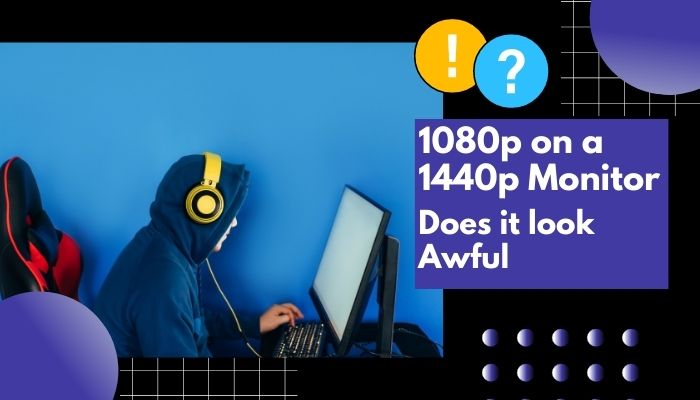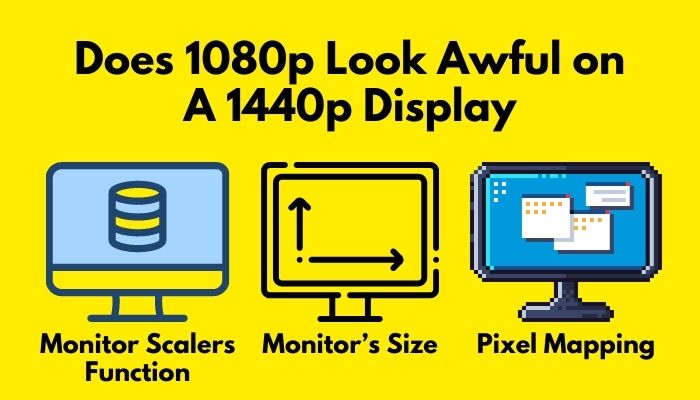While playing Warzone on your new upgraded 1440p monitor, you face frequent lagging in the game cause you are using an old GTX 1050 GPU. Maybe it’s time to lower the resolution from 1440p to 1080p!
Will it boost the performance of the gameplay, and how does it look?

Are these types of questions hovering in your mind? Let me clear all the questions for you.
As a gamer, I am currently using a 4k monitor. So, I understand why these types of questions arise in your mind. But after dealing with these types of scenarios, now I know how to deal with them.
Get your reading glass and read till the end to get all your answers cause I have explained them deeply in this article.
Can You Run 1080p on a 1440p Monitor?
Yes, you can run 1080p resolution on a 1440p monitor. But the image quality will be compromised. The images will not look as sharp as the 1440p native resolution cause they will be upscaled. Depending on the monitor’s scaler capability, you will face blurriness, fuzziness, and visual artifacts.
When you buy a gaming monitor, resolution becomes the priority. You might not run all the games after purchasing a 1440p monitor for your gaming rig due to an old GPU. Meanwhile, it can barely run the games with high settings and 1440p resolution.
So should you go for a 1440p monitor if you don’t plan to upgrade your GPU soon? Can you get sharp images by forcing a 1440p monitor to display a lower resolution?
Definitely! If you force it to display 1080p on your 1440p display, it will affect the image quality. Video scalers upscale the images to adjust to the native pixels while lowering the resolution in a higher-resolution supported display. Upscaling becomes the primary task of adjusting all the lower resolutions.
You won’t get your desired sharp images as you wish to see on your 1440p monitor after reducing the resolution.
FPS will increase after lowering the resolution. 1440p requires more processor power and rendering power to support that enormous resolution. With a higher pixel count display, you will not get a decent amount of FPS. To achieve higher FPS, you need to tune down the game’s settings.
Check out the easiest way fixes for Motherboard can’t detect Monitor.
Does 1080p look awful on a 1440p Display?
You can undoubtedly watch movies and videos or perform general computer tasks with a higher 1440p display. These types of work don’t require a high amount of GPU horse power. In addition, lowering the resolution will affect the image quality. You will see blurry images and texts. Monitor with a good scaler feature may give you sharp image quality.
A large monitor with a 1080p resolution will not provide sharp picture quality. Games will look more brilliant if you play 1080p games on your 1080p monitor. Scaling it down to 1080p on your 1440p monitor, you will see the lack of details. Several factors are responsible for how images appear on a 1440p monitor if you lower the resolution.
Here are the factors which determine how 1080p will appear on a 1440p monitor:
1. Monitor Scalers Function
Monitor scaler is a program that is embedded in the monitor. It is programmed to expand or shrink the images to fit the adopted resolution. Scaler’s functionality determines how your images will look after you reduce the resolution.
Having a good scaler functionality indeed produces a decently sharp image. A good scaler can upscale or downscale a picture to match the resolution. Scaler’s main job is to fix the blur and fuzziness when it tries to extend the frame.
But a lousy scaler or low profile scaler will process the image without correcting blur and visual artifacts. Then you will find it so awful to look at. So, scalers play an essential role when you set 1080p on a 1440p monitor.
2. Monitor’s Size
Monitor’s size is significant when displaying low resolution in a higher resolution display.
You will not see sharper images on a smaller display when the screen size increases. For example, a 32-inch display with 1920×1080 resolution will not provide pictures as sharp as a 24-inch display with the exact resolution.
When you decrease the resolution on a bigger screen, you will see fewer details and blurriness in the images. You only face minor issues in the smaller size displays because the higher pixel count will produce a much clearer picture.
3. Pixel Mapping
To run lower resolution in a higher resolution supported monitor, you can also go for the 1:1 pixel mapping feature on the monitor.
1:1 Pixel mapping is a video display technology that helps to display native fixed pixels. If you turn on pixel mapping, it will show you lower resolution images without scaling it. This tech will crave out the exact 1080p size into your 1440p monitor. You will see black bands around the picture, which is the only downside.
If you aren’t irritated by the empty black band, it could be a good option for you.
Have some time to spare? Quickly check out our epic guide on how to hook up dual Monitors.
Pros of 1080p on a 1440p Monitor
Step down the resolution to 1080p on a 1440p monitor can bring some luck to you. You can achieve several benefits by doing so.
Confused! What advantages can you get when you lower the resolution on a higher resolution-based monitor? Let’s hop on to it.
Here are the pros of setting 1080p resolution on a 1440p monitor:
1. Gaming Improvement
While gaming, you might want to lower the resolution if your GPU struggles to deliver the power to support 1440 resolution. To fix this, you can reduce the resolution to 1080p, and you will see gaming FPS increases rapidly. Even you can see three-digit FPS in the game.
For getting the higher frames, you can lower the resolution if you don’t want to get the smoke out of your GPU. To squeeze the extra frames out of the game sometimes, you turn down anti aliasing, reduce shadows, and other settings.
To play games at 1440p, you need a powerful rig. For achieving 30, 60, or even 120 FPS, you require a high-end GPU. But when your mid-range GPU struggles to pump up the game, lowering the resolution gives you both advantages and disadvantages.
You may face less detailed game play, blurry images, or even face lags while gaming. But FPS will surely improve. One thing you must keep in mind that you will get more flexibility from a 1440p monitor by gaming in 1440p,1080p, or even 720p, which you don’t get on a 1080p monitor.
Here’s a complete guide on how to set Monitor to 144hz easily.
2. Streaming
You can see not every streaming content is available above 1080p. Hence, if you want to stream over 1080p, you will need a lot of extra bandwidth. Not many people can afford higher bandwidth.
You can watch Blu-ray content on your 1440p monitor even if your content is in 1080p. The monitors can use the video scaling program to scale the resolution. Many streaming servers won’t allow you to stream anything over 1080p.
As a game streamer, you might want to play the games in 1080p because you can only stream live gaming in 1080p. While playing games in 1440p, you can only upload the videos in 1080p. So, switching down the resolution to 1080p on a 1440p monitor can fuel up your gaming performances and stream simultaneously.
Also, check out our separate post on how to use Mouse on second Monitor while gaming.
3. Work Faster
If you want to work on a 1440p monitor, it will help by giving you extra sharp, detailed images and texts. You don’t have to zoom in to 120% to read out all your doc files and emails.
But more resolution means you need more processing power and more rendering power from the GPU. Lowering the resolution will need less processing power. So, it will make your processor work faster and finish all the work rapidly. Faster is better, right?
Pro Tip: Try to lower the render settings on the game and keep the resolution as same. It will increase FPS while you can still game on 2160p, 1440p, or 1080p resolution.
Cons of 1080p on a 1440p Monitor
It will make your images less sharp, or you will see blurry images, and text will be fuzzy. You might see visual artifacts, and sometimes you will face lags while gaming. As long as the scaling program in your monitor is not capable enough, you will see worse images.
Setting up 1080p on a bigger 1440p monitor will produce more blurry images. A bigger screen has fewer pixels per square inch, and you won’t be benefited much.
When running a game on a 1440p monitor with 1080p resolution, video scaler programs stretch out the pictures and produce blurry images. Video scaling programs use a complex algorithm to deal with both down scaling and up scaling processes. It doesn’t perfectly do the job all time.
1440p provides 76% bigger resolution than 1080p. So, the video scaling process is not capable enough to scale the images perfectly. Hence, blurry images and lag in the game can make your gaming and overall working experience unsuitable if you switch to 1080p on a 1440p monitor.
Last Words
So, now you know it is possible to run 1080p on a 1440p monitor. But you will have to face terrible image quality. Blur images with fuzzy text can make give you a tedious experience.
Furthermore, video scaling will make the image stretch out and fit into the screen. The high-performance-based monitor comes with high-level video scaling programs built into it. High-level scaling does an excellent job presenting the same good image quality as the native resolution.
I think this article has helped you a lot. Now you understand how all the scaling and screen mapping things work when running 1080p on a 1440p monitor. It has all the upsides and downsides.
Please leave a comment if you want to clear out any topic. See you at the next one.




